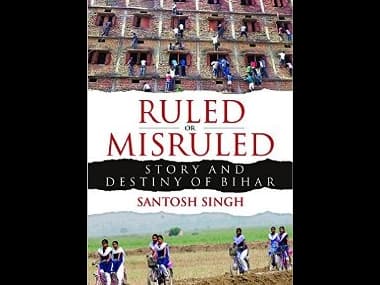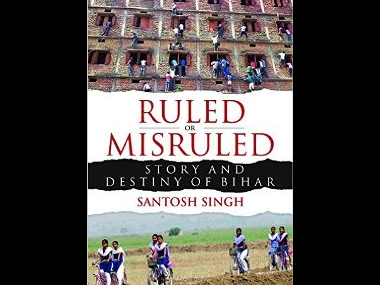Journalism may be history in haste, but it contributes a great degree to our understanding of the social and political complexities around us. It often provides enough material for future historians to explain trends to the posterity. Santosh Singh’s book, ‘Ruled or Misruled: The story and destiny of Bihar’ is a treasure trove of such material. Bihar has always been a cauldron of conflicting ideas and forces. Yet it steadfastly refuses to respond to any particular trend. This confuses scholars and often heightens their dilemma, prompting them to invent euphemisms for the reality which later turns into truisms. That is also the precisely the reason why most scholars and journalists on Bihar are caught in an internal conflict which is difficult to resolve. [caption id=“attachment_2493228” align=“alignleft” width=“380”] The cover of Santosh Singh’s book Ruled and Misruled: The story and destiny of Bihar, published by Bloomsbury[/caption] Santosh Singh, a journalist to the core, evades the intellectual trap by offering an unbiased chronicle of events and truthful reporting of facts on the ground. The book is shorn of academic jargon and complex verbiage, yet it offers a deep insight into a state which remains an enigma for the rest of India, except the Biharis themselves. The book, spread across 21 chapters, is truly a treat even for those who claim to know a lot about the state. For instance, his ground reporting on evolution of a private upper caste (Bhumihar) army — Ranbir Sena — from Ikbari village of Arra district is superb and revealing. After the killing of Ranbir Sena chief Brahmeshway Mukhia, the faux pas committed by the administration and abominable conduct of certain political leaders have been quite deftly dissected. The book chronicles the stories about “rule and misrule” under the Lalu Yadav-Rabri and Nitish Kumar regimes till Prime Minister Narendra Modi launched his first political campaign from Muzaffarpur. Similarly, for the first time, Singh’s book has brought out the fact quite clearly that there was nothing personal about Nitish Kumar’s aversion to Narendra Modi. Till 2005, Nitish was quite in awe of Modi and had never shown his pathological distaste for a man who he predicted would lead the country one day. It all happened between 2005 and 2010 when Nitish Kumar’s stock soared and his political equity was seen as not inferior to Modi’s in their respective role of chief ministers. Nitish played a gamble and also paid a price. But the final dice is yet to roll. Maybe the results of the Assembly election on 8 November will put the matter into definitive perspective. The writer must have prepared a ground for writing a saga on this electoral battle which can easily be called as a defining moment of Indian politics. Singh’s book burdens the reader with so much information that it becomes difficult to arrive at any conclusion at the end of it. But that is precisely the writer’s motive. He wants to provide loads of information to readers and enable them to make their own decision. As a journalist who has been touring and writing extensively on Bihar, I have always found Santosh, assistant editor with The Indian Express, as one of those outstanding reporters who combine deep understanding of society with information. This is a rarity among reporters these days. Fortunately, he has maintained this discipline while writing the book, published by Bloomsbury. The cover page itself offers a hint to the seriousness inside. One half of it shows a picture in which young men are seen perched on a school building to help examinees cheat in high school and intermediate examinations. Yet another picture spread on the lower side shows girls cycling to schools. The contrast could not have been more explicit.
The cover of Santosh Singh’s book Ruled and Misruled: The story and destiny of Bihar, published by Bloomsbury[/caption] Santosh Singh, a journalist to the core, evades the intellectual trap by offering an unbiased chronicle of events and truthful reporting of facts on the ground. The book is shorn of academic jargon and complex verbiage, yet it offers a deep insight into a state which remains an enigma for the rest of India, except the Biharis themselves. The book, spread across 21 chapters, is truly a treat even for those who claim to know a lot about the state. For instance, his ground reporting on evolution of a private upper caste (Bhumihar) army — Ranbir Sena — from Ikbari village of Arra district is superb and revealing. After the killing of Ranbir Sena chief Brahmeshway Mukhia, the faux pas committed by the administration and abominable conduct of certain political leaders have been quite deftly dissected. The book chronicles the stories about “rule and misrule” under the Lalu Yadav-Rabri and Nitish Kumar regimes till Prime Minister Narendra Modi launched his first political campaign from Muzaffarpur. Similarly, for the first time, Singh’s book has brought out the fact quite clearly that there was nothing personal about Nitish Kumar’s aversion to Narendra Modi. Till 2005, Nitish was quite in awe of Modi and had never shown his pathological distaste for a man who he predicted would lead the country one day. It all happened between 2005 and 2010 when Nitish Kumar’s stock soared and his political equity was seen as not inferior to Modi’s in their respective role of chief ministers. Nitish played a gamble and also paid a price. But the final dice is yet to roll. Maybe the results of the Assembly election on 8 November will put the matter into definitive perspective. The writer must have prepared a ground for writing a saga on this electoral battle which can easily be called as a defining moment of Indian politics. Singh’s book burdens the reader with so much information that it becomes difficult to arrive at any conclusion at the end of it. But that is precisely the writer’s motive. He wants to provide loads of information to readers and enable them to make their own decision. As a journalist who has been touring and writing extensively on Bihar, I have always found Santosh, assistant editor with The Indian Express, as one of those outstanding reporters who combine deep understanding of society with information. This is a rarity among reporters these days. Fortunately, he has maintained this discipline while writing the book, published by Bloomsbury. The cover page itself offers a hint to the seriousness inside. One half of it shows a picture in which young men are seen perched on a school building to help examinees cheat in high school and intermediate examinations. Yet another picture spread on the lower side shows girls cycling to schools. The contrast could not have been more explicit.
Making sense of Bihar: A look at the indecipherable state through unjaundiced eyes
Ajay Singh
• November 3, 2015, 12:09:29 IST
Santosh Singh’s book, ‘Ruled or Misruled- the story and destiny of Bihar’ is a treasure house of material for future historians to explain trends
Advertisement
)
End of Article